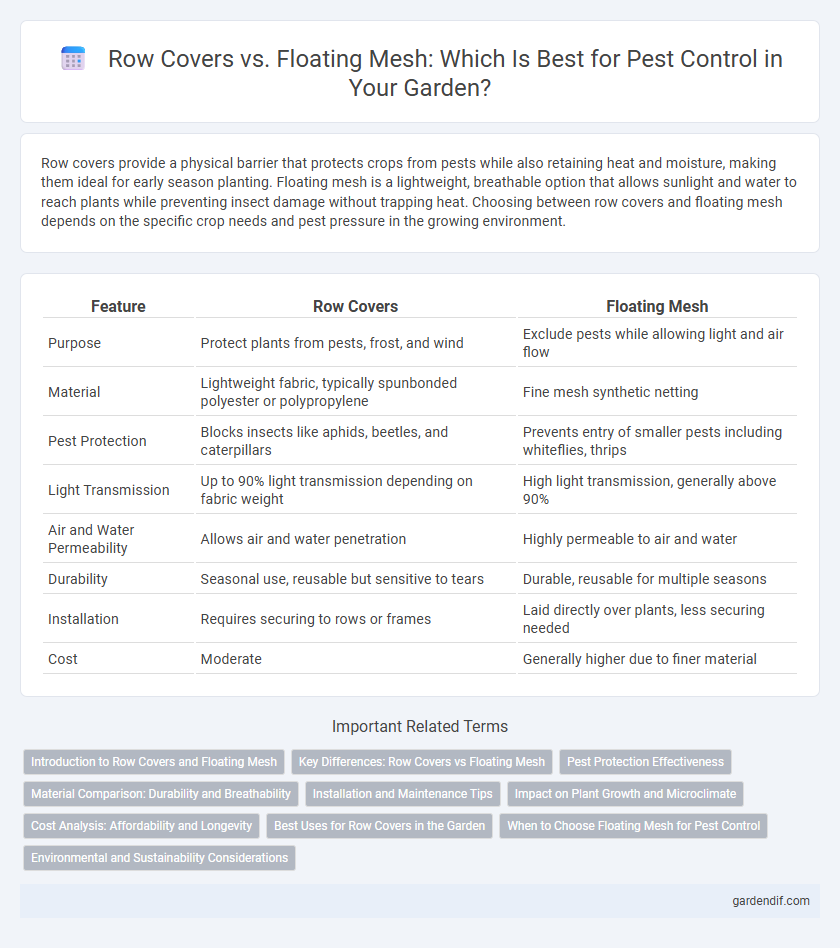
Row covers vs floating mesh Illustration
Row covers provide a physical barrier that protects crops from pests while also retaining heat and moisture, making them ideal for early season planting. Floating mesh is a lightweight, breathable option that allows sunlight and water to reach plants while preventing insect damage without trapping heat. Choosing between row covers and floating mesh depends on the specific crop needs and pest pressure in the growing environment.
Table of Comparison
| Feature | Row Covers | Floating Mesh |
|---|---|---|
| Purpose | Protect plants from pests, frost, and wind | Exclude pests while allowing light and air flow |
| Material | Lightweight fabric, typically spunbonded polyester or polypropylene | Fine mesh synthetic netting |
| Pest Protection | Blocks insects like aphids, beetles, and caterpillars | Prevents entry of smaller pests including whiteflies, thrips |
| Light Transmission | Up to 90% light transmission depending on fabric weight | High light transmission, generally above 90% |
| Air and Water Permeability | Allows air and water penetration | Highly permeable to air and water |
| Durability | Seasonal use, reusable but sensitive to tears | Durable, reusable for multiple seasons |
| Installation | Requires securing to rows or frames | Laid directly over plants, less securing needed |
| Cost | Moderate | Generally higher due to finer material |
Introduction to Row Covers and Floating Mesh
Row covers are lightweight fabric barriers designed to protect crops from pests, frost, and harsh weather while allowing sunlight, air, and moisture to reach plants. Floating mesh, often used in a similar manner, consists of a netting material that provides physical protection against larger insects and birds without significantly altering airflow or light penetration. Both row covers and floating mesh serve as essential pest management tools in integrated pest control strategies.
Key Differences: Row Covers vs Floating Mesh
Row covers provide a dense, fabric barrier that protects plants from pests while retaining heat and moisture, ideal for frost protection and insect exclusion. Floating mesh features a lighter, more breathable material allowing better air circulation and light penetration, making it suitable for warmer climates and pests like birds and larger insects. The key differences lie in material density, thermal insulation, and target pest protection effectiveness.
Pest Protection Effectiveness
Row covers provide a dense physical barrier that effectively prevents a wide range of pests, including aphids, beetles, and caterpillars, from reaching plants, thereby reducing infestation significantly. Floating mesh offers superior breathability and light penetration but may have larger openings that allow smaller pests to bypass the barrier, potentially decreasing its overall efficacy against tiny insects. Both materials contribute to integrated pest management, but row covers typically offer higher pest protection effectiveness in diverse agricultural settings.
Material Comparison: Durability and Breathability
Row covers made from spunbonded polypropylene offer superior durability with resistance to tearing and UV degradation, ensuring multi-season use, while their breathable fabric maintains optimal airflow to prevent heat buildup and moisture accumulation. Floating mesh materials, often crafted from woven polyethylene or nylon, provide excellent breathability with a lightweight structure that supports airflow and moisture evaporation but may be less durable against strong winds and repeated handling. Both materials balance pest exclusion and plant health, though row covers excel in longevity, whereas floating mesh offers enhanced ventilation for sensitive crops.
Installation and Maintenance Tips
Row covers offer straightforward installation by securing edges with soil or staples, providing consistent protection and easy access for watering and weeding. Floating mesh requires careful anchoring to prevent displacement by wind or animals, with more frequent adjustments necessary to maintain close contact with plants. Regular inspections ensure both materials remain effective, avoiding pest entry while minimizing plant damage.
Impact on Plant Growth and Microclimate
Row covers create a warmer microclimate by trapping heat and moisture, which promotes faster plant growth and earlier crop yields. Floating mesh allows better air circulation and sunlight penetration, reducing the risk of overheating and fungal diseases while maintaining moderate growth rates. Choosing between these options depends on crop sensitivity to temperature and humidity levels needed for optimal development.
Cost Analysis: Affordability and Longevity
Row covers generally offer a more affordable initial investment than floating mesh, making them suitable for large-scale pest control on a budget. Floating mesh, while typically more expensive upfront, provides greater durability and longevity, reducing replacement frequency and long-term costs. Evaluating cost per season, row covers suit short-term use, whereas floating mesh delivers better value in multi-season pest management.
Best Uses for Row Covers in the Garden
Row covers provide an effective barrier against insects like aphids, cabbage worms, and flea beetles while allowing sunlight, air, and moisture to reach plants, making them ideal for protecting vegetables such as lettuce, spinach, and brassicas. They also create a microclimate that promotes earlier germination and extends the growing season by shielding plants from frost and wind. Floating mesh is more suitable for delicate crops requiring gentle protection and better airflow but less frost resistance compared to row covers.
When to Choose Floating Mesh for Pest Control
Floating mesh is ideal for pest control when early-season protection is crucial against small flying insects like aphids and whiteflies. Its lightweight, breathable design allows for air and light penetration while preventing pest access without harming delicate plants. Use floating mesh in warmer months when continuous ventilation is needed to reduce moisture buildup and prevent fungal diseases.
Environmental and Sustainability Considerations
Row covers and floating mesh differ significantly in their environmental and sustainability profiles, with row covers typically made from biodegradable or recyclable materials that reduce plastic waste in agricultural practices. Floating mesh often provides a reusable option that minimizes chemical pesticide use, promoting ecosystem health and preserving beneficial insect populations. Selecting either method influences sustainable pest management by balancing material lifecycle impacts with effective pest exclusion to support long-term agricultural productivity.
Row covers vs floating mesh Infographic

 gardendif.com
gardendif.com